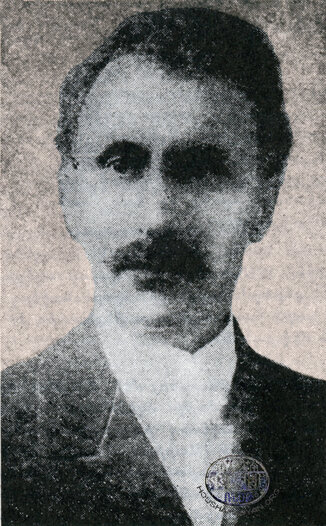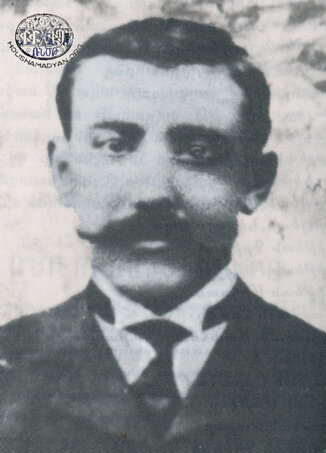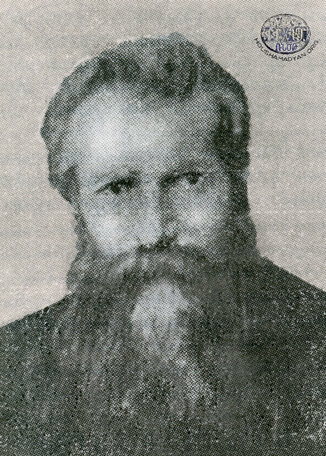Yozgat - Schools
Author: Vahé Tachjian, 14/09/15 (Last modified 14/09/15)- Translator: Hrant Gadarigian

Before discussing the Armenian schools that operated in the town of Yozgat and surrounding villages (Vilayet of Ankara) during the Ottoman Empire, let’s start by examining the educational organizations that assisted these schools and which played a primary role in building schools and fostering learning in the area.
These organizations were the principal founders of many of the area’s schools and attempted to support them financially afterwards, including covering teachers’ salaries and student expenses.
What follows is a list of these organizations prepared by the Mkhitarist Bishop Yeprem Boghosian (1887-1972):
Lousavorchagan Ungeroutiun(Enlightenment Association): Founded in 1852 by Archimandrite Mgrdich Dikranian, the Primate of Yozgat. It is believed to be the oldest education organization in the town of Yozgat. In addition to fostering the education of boys, the organization made efforts to open a school for girls. While the organization registered success in the region, it is noted that the girls’ school closed after a brief period. A girls’ school was only opened in Yozgat after the reestablishment of the Ottoman Constitution in 1908.
Ohanian Association: Established in 1870 or 1871. In 1872 a school bearing the name Ohanian was established in the town of Yozgat. The school didn’t last for long.
Vahanian Association: Founded in 1872 by Bishop Arisdages Tertsagian. The organization establishes a school with the same name. Despite the school having a small number of students, it is believed to have operated until 1915. Graduates of the Vahanian School establish the Krasirats (Lovers of Letters) Association in 1885. It was able to build a library for the school.
Antsnver Association: Founded in 1876. In 1883 it establishes a reading room adjacent to the upper cemetery in the town of Yozgat where local Armenians could read newspapers and books. The organization also financially assisted Yozgat’s ‘Mother School’.
Khorenian Association: It was founded in 1878 and immediately opened the Khorenian School in the town of Yozgat. After successfully operating for a few years, it later was reduced to a kindergarten in the mid 1880s.
Setian Association: Founded in 1879 by Mnatsagan Semerjian of Zeytoun. In 1882 it opened a school, called Setian, in the village of Terzili.
Armenouhian Association: Founded in 1881 by Yozgat Vice-Primate Bishop Ghevont Shishmanian. It sought to foster education for girls. It is believed that the association established a school bearing its name. The association and school didn’t last for long.
Other associations recorded in the annals include Aramian (founded 1876-78), Lousaspiur (1876-77), Ousoumnasirats (1885), Tbrotsagan (1885), Aghkadasirats (1889), Djshmardasirats (1889) and Harachatimasirats (1908). [1]

The Town of Yozgat
Education in the town took off in the 1880s. In prior years students mostly received religious learning reading the Bible or Nareg.
In the second half of the 19th century, Ohan amira Arslanian (1784-1874) sponsored the construction of an Armenian school (better known as the Mother School) in the courtyard of Yozgat’s diocese. The benefactor also initiated construction of shops along both sides of the road leading from the church to the Tash Khan Bridge. Income from the stores covered expenses of the church and school. Ohan Arslanian was a prominent figure in the Yozgat area. He was able to amass wealth, power and position via the patronage he enjoyed of the Chapanoghlu (derebey/feudal) family. This family was considered the largest landowner in the entire region. Arslanian had risen to the rank of chorbadji; i.e. he served as mediator between Yozgat Armenians and the feudal family regarding a host of matters. Arslanian launched a number of construction projects in the town. It is noted that he purchased the tithe (ashar/aşar) for the entire Yozgat prefecture from the Ottoman government. Arslanian often used this influential position for the benefit of various Armenian undertakings; for example the construction of schools and churches. [2]
Initially, this school built with Arslanian donations, was a typical one offering an education only to boys. With an enrollment of 350, it consisted of a kindergarten, primary school and high school. Simon Hekimian served as principal in the early years. Teachers we know of were Father Parsegh (from Germer village) and instructor Parsegh (Marzvan). [3]
In 1908, Yozgat Primate Archimandrite Khoren Timaksian (1864-1915) initiated the dismantling of the old school building and the construction of a beautiful three story edifice on the grounds of the cemetery in its place. It was named the Timaksian School in honor of the primate. The primary school was located on the ground floor. A large auditorium was located on the first floor, and the upper floor housed middle and upper level classrooms. [4]
After 1908, Krikor Alchudjian from Talas assumed management of the school. During his term as principal, a disagreement cropped up between him and the primate, which led to a split amongst those Yozgat Armenians united around the school. In the end, the group opposed to the primate left and a second school was established in the town. We have no information regarding it. It is recorded that Catholicos Sahag II of Sis mediated between the opposing groups. [5]
In 1914 Bishop Nerses Tanielian (1868-1915) succeeded Archimandrite Khoren Timaksian as primate. During the former’s reign, education in Yozgat and neighboring villages is given a new boost. The new primate particularly encourages schooling for girls. Tanielian is killed during the Genocide. [6]
Other Schools in the Town of Yozgat

Vahanian School
The Vahanian School, a private institution educating boys, operated in the 1870s. A. Boyadjian was principal and enrollment was around thirty. Parsegh Derounian taught at the school. The Hamazkayin Coed School was also private. The Khorenian School, consisting of a kindergarten, is another school we know of. Avedis Mashlakdjian and Hagop Gortian taught there. A school named Miapanian also operated in Yozgat. Teachers included Hagop Miapanian and Roupen Bedrosian. Mihran Kiurkdjian simultaneously served as principal at Miapanian and Khorenian. It is believed that Khorenian and Vahanian operated until 1915. [7]
Protestant School
This school was sponsored by the American Missionary Association. It was a two story building teaching girls and boys. Aram Torosian was principal. [8]
Catholic School
The school was built in the 1890s at the initiative of Archimandrite Hovsep Krmzian, primate of the area’s Armenian Catholics. [9]
Other Schools in the Yozgat Region

Boğazlıyan
There were two divisions in this school; one for boys and another for girls. The boys’ school was older. The girls' school was established around 1912. [10]
Peohreng (present-day Gümüşkavak)
This village of 150 Armenian families, alongside 300 Turkish households, had a modest Armenian school built next to the St. Hagop Church. [11]
Karahalli
While this village of 400 Armenian households didn’t have its own Armenian school, Hadji Yeghiayian (a prominent resident) turned one of the large rooms in his house into a school. Kevork Papazian taught her. [12]
Eğlence
The village had two schools – an Armenian Apostolic one (Apkarian School) and an Armenian Protestant one. Some who graduated these schools went on to continue their education at the American Colleges of Marzvan and Talas. [13]
Terzili (present-day Sarıkaya)
An Armenian primary school, affiliated with the local St. Toros Church, existed in the village. The Setian School, constructed in 1881 by an association with the same name, also operated in the village. [14]
Iğdeli
The Armenian school in this village was relatively old. After 1908, this school was turned into an institution of higher learning, particularly due to the efforts of Hadji Krikor agha Kalousdian - grandfather of Constantinople Patriarch Archbishop Shnork Kalousdian (1913-1990). The new school was a two story stone and marble edifice. It was christened the Bartevian School and boys from the surrounding villages attended. We know that the Kalousdian and Torosian families underwrote the school’s expenses. [15]
Incirli
The Aramian School, with its boys and girls annexes, operated in this village. It was built next to the St. Asdvadzadzin Church. [16]
Iurnedj (present-day Konuklar)
The village had a school named Lousavorchian, built adjacent to the St. Asdvadzadzin Church. [17]
Gürden (present-day Yazıkışla)
An Armenian school, adjacent to the St. Asdvadzadzin Church, operated here. Mesrob Chiftdjian is one the teachers we know of. [18]
Menteşe
The village had two Armenian schools – one belonged to the Apostolic Church community and the other to the Protestants. The latter was the better of the two and had a larger enrollment, including Turkish pupils. [19]
Uzunlu
Two churches, each having their own school, existed in this Armenian village of some 500 households. [20]
Çakmak
The Armenian Apostolic and Protestant communities each operated their own coed schools. Garabed Effendi Giulian, Hrant Yardumian, Sevdayian and Atam Effendi are the teachers we know of. [21]
Çokradan
This 200 household Armenian village had a school built next to the St. Teotoros Church. Fathers Emmeian and Okoumoushyan taught at the school. In 1908, after the restoration of the Ottoman Constitution, the village’s Armenian school was improved. Local Turkish pupils started to attend as well. [22]
Belören
The village had a school with 150 pupils. Hagop Berberian (from Rumdigin) taught here with assistants Taniel and Avak. [23]
Burunkışla
This town’s Armenian school was called the Aramian National School. It was a two story stone structure. Minas Bedrosian served as director. In 1908, he was succeeded by Zakeos Ayvazian, a graduate of the seminary (Jarankavorats) of the St. Garabed Monastery in Gesaria/Kayseri. Ayvazian remained at the post until conscripted in the army in 1914. Ghazaros Hintlian then became director. Mihran Tavitian, Sarkis Torosian, Krikor Arzoumanian and Roupen Shehirlian comprised a portion of the teaching staff. Isgouhie Tavitian served as director for the girls’ division. The school’s teaching staff consisted of three female and five male teachers.
The first graduates of the boys’ school were Hairabed Benlian, Giulbeng Benlian, Aram Ohanian, Aram Demirdjian, Lutfig Torosian, Antranig Boghosian, Roupen Karageozian and Ghevont Sahagian.
Prior to the Genocide, there was a project to establish a separate girls’ school in Burunkışla and to raise the boys’ school to the second level. Funds are raised to construct the new buildings, an architect selected and the foundations laid, but the work was never completed due to the massacres and evictions of 1915.
There were 15 Protestant households in the village that had their own school with 50 pupils. Misak Effendi served as director. [24]
Rumdigin (present-day Felahiye)
This Armenian school (Bartevian) of this town with 750 Armenian households with built adjacent to the St. Asdvadzadzin Church. Prior to the 1890s, lessons were on a primary level, limited to a reading of the Psalms and Breviary. The main aim of the school was to prepare candidates for the priesthood.
After 1895, Sahag Giulshenian (from Bardizag) was invited to teach and he introduced a series of reforms within the school. He served as principal for more than ten years. During his tenure, the old school was demolished and a modern school was built to replace it. Lessons started from the primary school level. Lessons in vernacular and classical Armenian grammar were introduced, as well as Turkish, geography, Armenian history, arithmetic, music, and English.
The school was a one story structure. To enter, one had to climb several steps to reach a hall that had an adjacent room for lessons. The floor was made of wood and the building had its wood shed. Every winter pupils were obligated to bring firewood to heat the school. The building mostly lacked writing tables and pupils sat on cushions brought from home. Desks existed only for the upper two classrooms. Classes went up to the high school level. Those wishing to continue their education generally attended the Gesaria/Kayseri St. Garabed Seminary or the Talas American College.
In 1913 the school’s theater group performed Bedros Tourian’s play “Black Lands”.
Avak Kalfayian, Serop Kalfayian, Sahag Giulshenian, Sahag Yeshilian, Apraham Yeshilian, Krikor Berberian, Levon Karayian, Kevork Karayian,Kevork Melkonian, Madteos Ghalfa, Hagop Berberian and Krikor Zepiurian are the names of the teachers we know of.
Some local Turkish families sent their children to the school.
The small Protestant community of Rumdigin had its own school that also served as an assembly hall. [25]
Saray
The village school had 100 pupils and was located adjacent to the St. Asdvadzadzin Church. Local Turkish families also sent their children to the school. [26]
Keller (present-day Yenipazar)
This town had an Armenian school called Vahanian with an enrollment of 200-250. Those who served as principal: Haroutiun Diulgerian (Yozgat), Sarkis Toshigian, Soghomon (Karayaghoub), Minas Bedrosian (Burunkışla), Hairabed Ayvazian (killed in 1915). [27]
Köhne (present-day Sorgun)
This 400 Armenian household village had a primary school housed in a two story structure with an enrollment of some 200. Work to build a two story girls’ school was completed in 1915, but it never opened due to the eviction and destruction of Armenians. We know that Krikor Tavitian (a graduate of the Talas American College killed in 1915) served as principal. [28]
Other Schools
In the sandjak (district)of Yozgat, Armenian schools operated in the following villages: Karayakup, Karabeyuk, Kuzuldjuh Ova, Geovedjli, Çatak, Bebek, Saatluh, Sachluh, Saruh Hamza and Deli Hamza. [29]

- [1] Armen Tarian, Antranig Yerganian (editors), History of Armenians of Yozgat and Environ (Kamirk) [in Armenian], Published by Compatriotic Union of Yozgat and Environs, Beirut, 1988, pp. 280-283; Nouritsa M. Pilibosian, Avedis Kesdekian (A. Gabents), Vahe Haig, Memorial to People of Yozghat (Yozgat) [in Armenian], Fresno, 1955, pp. 91-95.
- [2] Tarian, History of Armenians…, pp. 53-54.
- [3] Ibid, pp. 54, 286-289; Pilibosian, Memorial to People…, pp. 27, 53.
- [4] Tarian, History of Armenians…, p. 54; Pilibosian, Memorial to People…, p. 57.
- [5] Tarian, History of Armenians…, p. 55.
- [6] Pilibosian, Memorial to People…, pp. 122-125.
- [7] Tarian, History of Armenians…, pp.54, 286-289; Pilibosian, Memorial to People…, p. 56; Sarkis M. Dzotsigian, Western Armenian World [in Armenian], New York, 1947, p. 196.
- [8] Tarian, History of Armenians…, p.57; Pilibosian, Memorial to People…, p. 56.
- [9] Tarian, History of Armenians…, p.286.
- [10] Ibid, p.84
- [11] Ibid, p.85.
- [12] Ibid.
- [13] Ibid, pp.87-88.
- [14] Ibid, pp.88-89; Pilibosian, Memorial to People…, p. 62.
- [15] Tarian, History of Armenians…, p. 90.
- [16] Ibid, p. 91.
- [17] Ibid, p. 91; Pilibosian, Memorial to People…, p. 62.
- [18] Tarian, History of Armenians…, p.93.
- [19] Ibid, pp. 94-95.
- [20] Ibid, p. 96; Pilibosian, Memorial to People…, p. 73.
- [21] Tarian, History of Armenians…, p. 101; Pilibosian, Memorial to People…, p. 79.
- [22] Tarian, History of Armenians…, p. 102.
- [23] Ibid.
- [24] Ibid, pp. 104-108; Pilibosian, Memorial to People…, pp. 82-84.
- [25] Tarian, History of Armenians…, pp. 109-112; Haigazoun H. Yapoudjian, Rumdigin Memory Book [in Armenian], Beirut, 1967, pp. 128-130.
- [26] Tarian, History of Armenians…, p. 113.
- [27] Ibid, pp. 115-116.
- [28] Ibid, p. 118.
- [29] Ibid, p. 119.














![Haigazoun H. Yapoudjian, Rumdigin Memory Book [in Armenian], Beirut, 1967 Haigazoun H. Yapoudjian, Rumdigin Memory Book [in Armenian], Beirut, 1967](https://www.houshamadyan.org/fileadmin/_migrated/pics/img887_web_01.jpg)